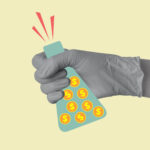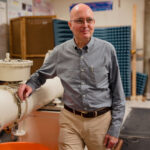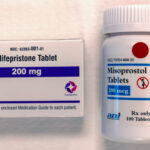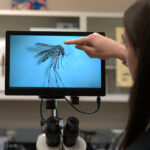In his State of the Union address earlier this month, President Trump made an ambitious pledge: to eliminate the HIV epidemic in the U.S. within 10 years. “Scientific breakthroughs have brought a once-distant dream within reach,” he said. The policy promise is no less bold than President George W. Bush’s global initiative PEPFAR (President’s Emergency Plan for AIDS Relief), which has been credited with saving more than 17 million lives since its inception in 2003. Whereas Bush’s initiative tempered the destructive force of AIDS, could Trump’s end it altogether?
The stakes are high in this choose-you-own-adventure, particularly for America’s marginalized communities. HIV/AIDS in the U.S. disproportionately affects gay and bisexual men, the transgender community, African Americans, the prison population, injection drug users, our inner cities, and other underserved communities. Half of black and a quarter of Latino gay and bisexual men are expected to acquire the disease in their lifetime. Four out of five women with HIV/AIDS in the U.S are black or Hispanic/Latina. And infection rates among injection drug have soared during the opioid epidemic.
According to a blueprint released by the Department of Health and Human Services, President Trump’s plan to end HIV will be focused on expanding efforts to diagnose, treat, and prevent cases of HIV/AIDS. Although the president’s initiative has potential to meet his stated goal, an overreliance on preventative and antiretroviral drugs could prove to be an unintended Trojan Horse. To permanently eliminate the scourge of HIV/AIDS, what we need isn’t just a motley mix of preventative half measures. What we need is a cure.
A pillar of the president’s plan is pre-exposure prophylaxis, or PrEP — medications that dramatically reduce the risk of contracting HIV. Among the best known of those medications is Truvada, a once-daily pill manufactured by the pharmaceutical company Gilead Sciences.
Although few people outside the gay community have heard of PrEP, it has caught on like wildfire among gay men. New York City’s Department of Health plastered subways and gay neighborhoods with alluring “Play Sure” ad campaigns, implicitly endorsing the new drug regimen as a first-line defense in situations of casual sex. A flurry of apparently underground, but highly polished, X-rated social media campaigns and internet memes— with taglines like “Truvada Whores” and “PrEP Squad” — sprouted up all over gay sites. The take home message for gay men: A pill a day will take HIV away.
Indeed, PrEP has been credited for a decline in HIV-infection rates in some communities. For HIV-discordant monogamous couples — those with one HIV positive and one HIV negative partner — PrEP may ultimately be the intervention of choice. In those cases, it’s possible to determine which viral strain is carried by the HIV positive partner and tailor a PrEP regimen that will guard against it.
The problem is that no single PrEP medication is effective against all strains. In a recent case study, for instance, the strains of HIV in some 6 percent of people living with HIV/AIDS had “high-level resistance” to Truvada. Can we reliably count on anti-retroviral drug therapy to virally suppress all of these people, all of the time? Over time, as condom use among men who have sex with men continues to drop, the emergence of new and existing drug-resistant strains of HIV/AIDS will surely accelerate. Left unchecked, this situation could lead us into a vicious cycle: Patients will require increasingly strong daily cocktails of increasingly ineffectual drugs just to stay healthy. And when that PrEP bubble bursts, the impact on high-risk communities could be catastrophic.
Only a cure, a vaccine, or both can end AIDS for good. As recently as a decade ago, such a cure was scientifically unthinkable. But then came a development that gave us reason for optimism: In 2007, Timothy Ray Brown, an American who had been living with HIV for more than a decade, became the first person to be cured of AIDS. Brown was cured using stem cells transplanted from a donor who was among the small fraction of the population that exhibits natural HIV resistance. Whether the same method can be applied to develop a widespread cure is uncertain: Patients would need to be paired with immune-matched, HIV-resistant donors, who can be exceedingly difficult to find. However, several research labs, including my own, are pursuing approaches that may allow them to use a patient’s own stem cells as the starting material to create curative stem cells.
I hold out hope that the final agenda for Trump’s initiative to end HIV/AIDS will include substantial support for a vaccine or cure — or, at the very least, that the spotlight he’s shining on the disease will spur others to take up the pursuit. It is no longer the science or the challenge of cellular engineering that stands in the way. Rather, it is primarily a question of leadership and our capacity for imagination. On at least this one point, Trump was undoubtedly spot-on: The once-distant dream is now within reach.
Kambiz Shekdar is president and founder of the Research Foundation to Cure AIDS (RFTCA). Prior to establishing the RFTCA, Kambiz served as Chief Scientific Officer of Chromocell Corporation, a biotechnology company he co-founded.











Comments are automatically closed one year after article publication. Archived comments are below.
The points made by Dr. Shekdar and respondent ME are real eye openers and should be read by every policy maker everywhere. It appears we’re becoming complacent because of the advent of the cocktails of drugs that appear to control HIV and AIDS and now by preventative drugs like Truvada. and the PREP campaign. But as Dr. Shekdar points out, these medications and programs are half measures and could turn around and bite us in the end — in our ignorance of how HIV mutates and comes in many many varieties, we eventually could/will be spreading rather than controlling the disease. A cure, which will involve many strains of cells specific to the strains of the virus infecting the individual, will require a large human participatory effort to locate and match the people the appropriate stem cells. It is the kind of effort human beings, especially Americans, are great at and is doable. But it will take a major education campaign, more research, and a massive effort to locate and link people and their curative cells. Imagine donating something that your body makes normally to someone who is ill and thereby curing them of a scourge that has already killed, or made miserable, millions of people. This is an opportunity we can not ignore.
The points made in this well written piece are sadly very true. I agree that PREP has been an essential tool in the arsenal to slow the increase in HIV infections, but what is missing, as the author pointed out, is a CURE. Just as with any diseases today most can be managed, but managing and curing are completely different. Does PREP have a place at the table, clearly it does, can the world and society rely on a pill as its only form of management – the answer is no. Its naive to think that a pill taken once a day to either keep from getting HIV, or to treat HIV will be the silver bullet. The medications are like being in a holding pattern when your trying to land a plane, the concept and actual act work for a while, but at some point the plane must land to refuel, and sadly at some point as stated above the medications taken for both prevention and management will fail to work, alas the plane will fall from the sky. The only true and lasting solution for this disease is an actual cure, and from what some have seen, and from what science has provided as witness evidence of a cure is achievable. I believe that all forms of protection, management and prevention are part of the arsenal but without a cure its like putting lipstick on a pig and trying to tell me its a cow. That Trump is attempting to say “look over here” as everything he touches seems to be investigated and full of lies the thought that he would take credit for the end of AIDS is disgusting at best. The man didn’t know the difference between HIV and HPV until Bill Gates explained it to him. If you think he is going to do anything have I got a bridge to sell you.